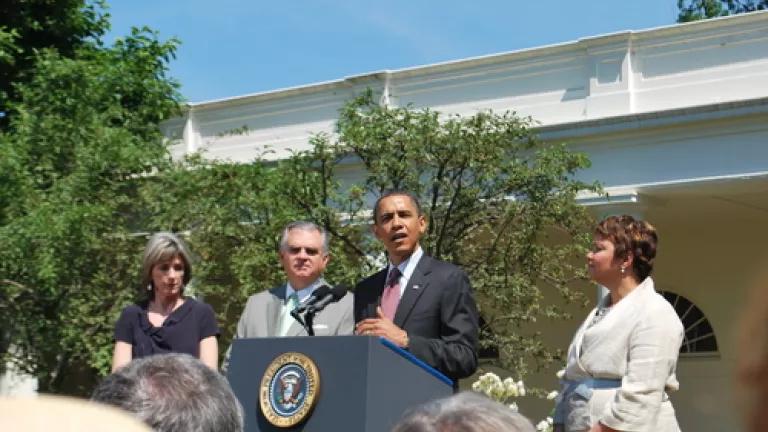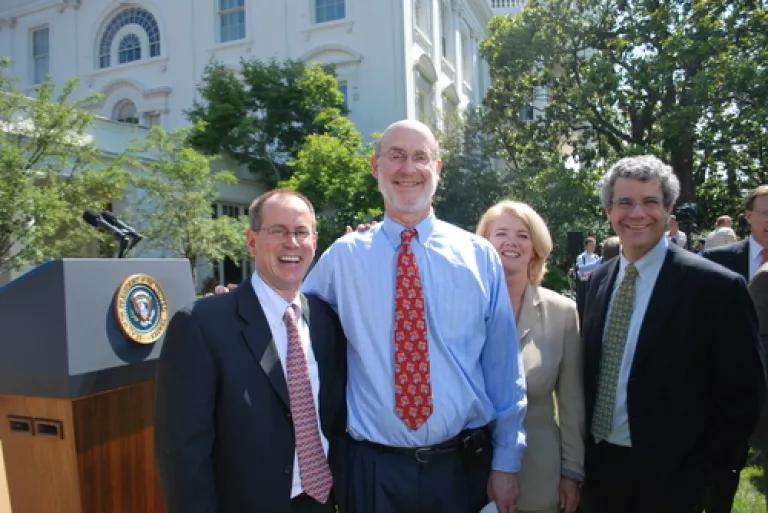
Almost exactly a year after the historic clean car peace treaty of last May, President Obama today announced two major new steps to reduce America’s carbon pollution and oil dependence.
The president instructed the Environmental Protection Agency and the National Highway Traffic Safety Administration, working closely with California and other stakeholders, to issue a second round of greenhouse gas and fuel economy standards covering cars and light trucks for model years 2017-2025. These will build on the clean car standards for the 2012-2016 model years announced last May and officially published this April.
The president also directed those agencies to work together with California and stakeholders on the nation's first-ever greenhouse gas and fuel economy standards for heavier trucks, from urban delivery trucks to 18-wheelers, that will be built in model years 2014-2018.

These new initiatives are big steps to curb America’s dependence on oil, cut our contribution to global warming, and help build industries and jobs of the clean energy economy. The cars and trucks on the nation’s roads and highways account for more than three-fifths of the oil we use and more than a quarter of our carbon pollution. These steps to cut oil use are especially welcome in the wake of the BP disaster in the Gulf of Mexico.
The new standards build on the clean car agreement announced at the White House one year ago, which brought together federal and state governments, industry, labor, and environmentalists in a remarkable agreement to cut pollution, improve our national security, and rebuild our economy. The second round of standards for cleaner cars, and the first-ever standards for heavy trucks, will save consumers billions of dollars at the gas pump, the grocery shelves, and the shopping center.
As President Obama said:
We know how important that is. We know that our dependence on foreign oil endangers our security and our economy. We know that climate change poses a threat to our way of life -– in fact we’re already seeing some of the profound and costly impacts. And the disaster in the Gulf only underscores that even as we pursue domestic production to reduce our reliance on imported oil, our long-term security depends on the development of alternative sources of fuel and new transportation technologies.
But we also know that our economic future depends on our leadership in the industries of the future. Around the globe, countries are seeking an advantage in the global marketplace by investing in new ways of producing and saving energy. From China to Germany, these countries recognize that the nation that leads in the clean energy economy will lead the global economy. And I want America to be that nation.
The President’s memorandum harnesses the know-how of two federal agencies and the state of California, which together have decades of experience bringing us cleaner, safer and more fuel-efficient vehicles. The memorandum specifically recognizes “the continued leadership role of California and other States,” which we know has been critical in achieving each round of progress towards cleaner cars and trucks.
President Obama set a bold, but thoroughly achievable target for America’s clean transportation future: “I believe that it’s possible, in the next 20 years, for vehicles to use half the fuel and produce half the pollution that they do today.”
Under the memorandum, EPA and NHTSA will work with California and other stakeholders to produce a technical assessment by September 1st of the potential for further carbon pollution reductions and fuel economy improvements through new and emerging technologies that can be deployed in new cars and light trucks through 2025. NRDC’s team of vehicle experts will roll up their sleeves and engage in this process. At the end of September, the federal agencies will publish a Notice of Intent announcing their findings and plans to propose and issue standards for 2017-2025.
Importantly, California retains the important role it has always had under the Clean Air Act. The Golden State can coordinate with the federal agencies again on harmonized national and state standards. But if the federal effort falls short, California has the option to issue its own standards, and other states can opt into the California program as well.
EPA and NHTSA will also propose carbon pollution and fuel economy standards this fall for medium- and heavy-duty trucks, which will be finalized by July 2011 and take effect in the 2014-2018 model years. The presidential memorandum projects, as an example, that big tractor-trailer rigs can cut greenhouse gas emissions by as much as 20 percent and improve fuel economy by as much as 25 percent.
The memorandum also instructs EPA, when setting new carbon pollution standards, to review and potentially strengthen standards for other vehicle emissions, such as the tailpipe standards for nitrogen oxides and toxic air pollutants, and standards for sulfur in gasoline.

President Obama concluded by pivoting from the transportation sector to the larger task of assuring our energy security and cutting carbon pollution across the economy. That included a clear push for the Senate to pass comprehensive clean energy and climate legislation:
Today’s announcement is an essential part of our energy strategy. But it’s not a substitute for other necessary steps to ensure our leadership in a new clean energy economy. I’m heartened by the good work that’s been done by Senator Kerry and Lieberman on a comprehensive energy and climate bill to reduce our dependence on foreign oil, to prevent the worst consequences of climate change, and foster the millions of new jobs that are possible if we rise to this challenge. And this follows the passage of comprehensive legislation through the House last June.
So as I’ve said before, I intend to work with members of both parties to pass a bill this year. (Applause.) In the meantime, I’m going to take every sensible, responsible action that I can use -- that I can take using my authority as President to move our country in the right direction. That’s what we’ve done today. That’s what we’re going to continue to do in the days, weeks and months ahead.
NRDC looks forward to working with President Obama to complete his clean energy and climate protection agenda by enacting comprehensive climate and energy legislation this year.
